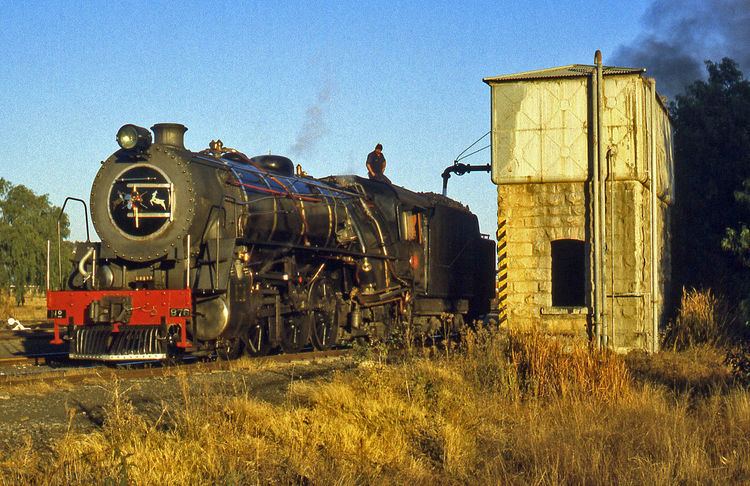Power type Steam Serial number 21749-21754 Build date 1930 | Builder Henschel and Son | |
 | ||
Designer South African Railways(A.G. Watson) | ||
The South African Railways Class 16DA 4-6-2 of 1930 was a steam locomotive.
Contents
In 1930, the South African Railways placed six redesigned Class 16DA steam locomotives with a 4-6-2 Pacific type wheel arrangement in passenger train service.
Manufacturer
An order for six locomotives for the South African Railways (SAR), similar to the Class 16DA Pacific type locomotives of 1928 and 1929, but built to an improved design, was placed with Henschel and Son of Kassel in Germany in 1930.
Characteristics
In an attempt to improve the steaming properties of further orders of Class 16DA locomotives, A.G. Watson, who had succeeded Colonel Collins as CME in 1929, designed a boiler of the Wootten type. It had a very wide firebox, with a grate area of 60 square feet (5.574 square metres). Watson was a firm believer in large firegrates with enlarged blast pipe caps, to give a reasonably low burning rate of fuel per unit of grate area, which improved boiler efficiency and reduced the emission of sparks and partially burnt fuel.
The boiler itself was of the same dimensions as that of the earlier locomotives in terms of girth and length between tube plates, the only difference being in the tube arrangement. The enlarged firebox, however, had a firegrate area which was 15 square feet (1.394 square metres) larger than the 45 square feet (4.181 square metres) of the earlier Hohenzollern and Baldwin-built locomotives. It was of comparable proportions to those which would later be installed on the Class 15E and Class 23.
This boiler and firebox was installed on these final six Class 16DA locomotives, numbered in the range from 874 to 879, which were built by Henschel and delivered in 1930. Compared to the earlier Hohenzollern and Baldwin-built locomotives, the steaming ability of the six Henschel-built locomotives was phenomenal and led to the adoption of wide fireboxes without combustion chambers as the standard on all subsequent SAR mainline steam locomotives.
The Henschel-built Class 16DA locomotives with their much wider fireboxes, their correspondingly larger grate areas and slightly larger diameter trailing wheels were sufficiently different from the Baldwin and Hohenzollern-builts to justify a separate classification, such as Class 16DB, but this did not happen and the locomotives ended up being known as the Wide Firebox Class 16DA.
Modifications
Five of these locomotives were delivered with Walschaerts valve gear. The last engine, no. 879, was built with Caprotti valve gear for experimental purposes. This rotary poppet valve gear was driven from a single gearbox on the centre of the driving axle. It was given a fair trial, but was eventually replaced with the standard Walschaerts valve gear in 1940.
They were all delivered with 60 inches (1,520 millimetres) diameter coupled wheels and with their boiler operating pressure set at 195 pounds per square inch (1,340 kilopascals). Four of them were later retyred with 63 inches (1,600 millimetres) diameter tyres on their coupled wheels. At the same time, their operating boiler pressure was raised to 205 pounds per square inch (1,410 kilopascals), to not have their tractive effort reduced by the larger coupled wheels.
When the larger tyres were fitted, the old tyres were left in position and turned down on the wheel centres to serve as liners, and the new tyres were then shrunk on over the liners. The practice of increasing the diameter of coupled wheels, wheel spacing and other considerations permitting, was begun by A.G. Watson during his term in office and was continued by his successors. The reduction of tractive effort caused by the larger wheels, was made up by increasing boiler pressures or by fitting larger cylinders or both, as required. This policy resulted in more mileage between heavy repairs, less cost-per-mile on repairs and locomotives capable of higher speeds.
Service
The locomotives were placed in service at Kimberley and worked the Union Limited and Union Express from there, south to Beaufort West and north to Johannesburg. They were never stationed at Braamfontein Loco in Johannesburg, but were serviced there in the process of working between Kimberley and Johannesburg.
When the Class 16E arrived in 1935, these Class 16DAs remained in service on the express trains in company with the new locomotives, which were also stationed at Kimberley and also worked north to Johannesburg and south to Beaufort West.
In 1939-1940, when new air-conditioned rolling stock was placed in service on the Union Limited and Union Express services between Cape Town and Johannesburg, all the Class 16DA and Class 16E locomotives were transferred to Bloemfontein in the Free State. From here, they continued to work passenger trains north and south, including the Orange Express, until the Class 15F replaced them and they were relegated to suburban and local passenger train work. They were withdrawn from service in 1973.
Preservation
No. 876 was the last of these engines to be kept in working order, being operated as part of the Transnet Heritage Collection and shedded at the Bloemfontein locomotive depot. No. 878 was plinthed at the Transnet Rail Engineering shops in Bloemfontein and was in excellent condition, since its location inside the works premises affords protection against South Africa's scrap metal scavengers.
During 2012, Atlantic Rail In Cape Town began fundraising efforts with the aim to eventually re-restore no. 879 to running order. She began steam testing in 2013, which culminated in a test run on the open line with a full load on 6 April 2014. She is based at Monument Station and is being used on weekend excursion trains to Stellenbosch.
Works numbers
The table lists the Class 16DA engine numbers, works numbers and variations in coupled wheel sizes.
